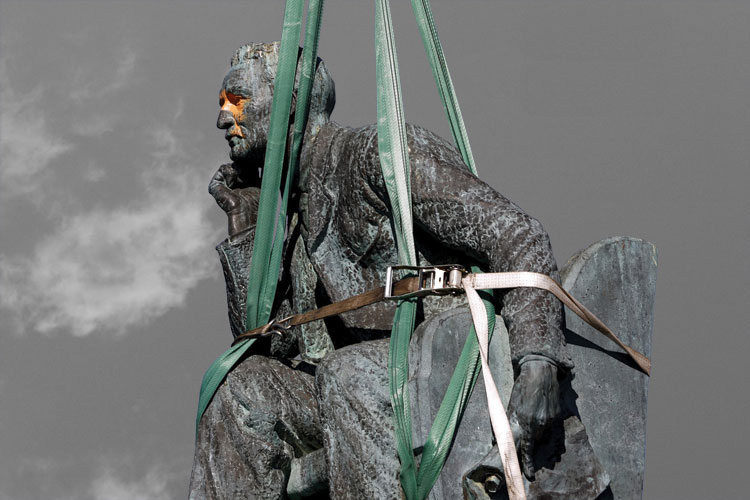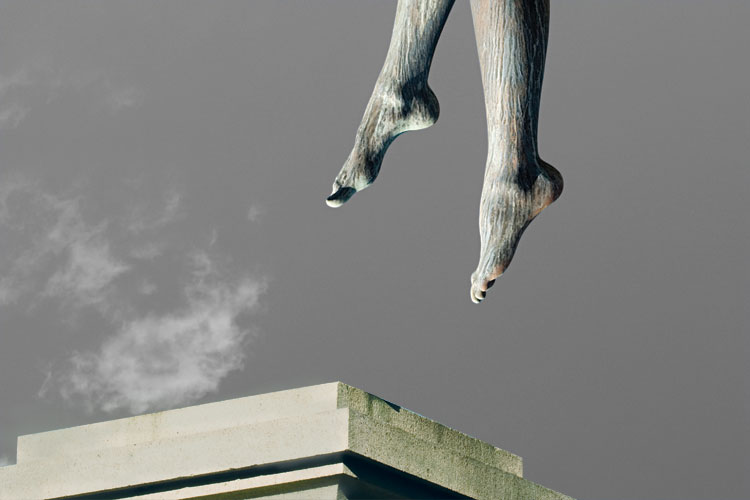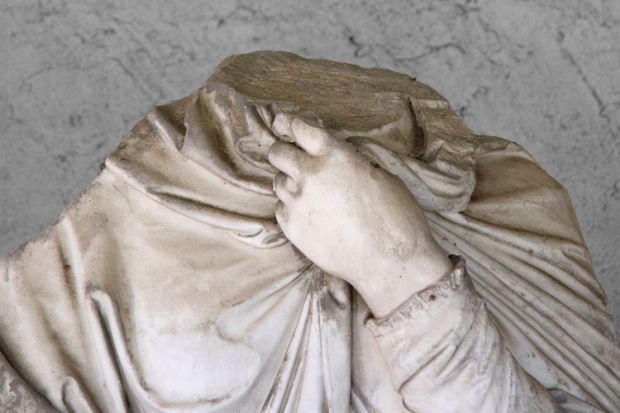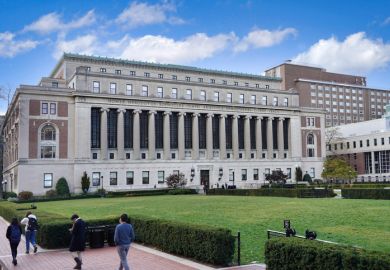Shriver Hall, which today serves as the central concert venue and geographical heart of Johns Hopkins University, was built in the 1950s, and was principally funded by the generous donation of Alfred Jenkins Shriver, an affluent attorney in Baltimore and member of the class of 1891. The donation was made on one condition – that a number of murals would be painted on its interior by the most able artist in the region. Today, two of these murals, set on adjacent walls, would make many scholars – the writer of this article included – want to burn the edifice of higher education to the ground.
On one wall, approximately 10ft across, was to be a mural of the great American philosophers who founded the department that had acquired a national reputation in the 1870s and 1880s: G. Stanley Hall (who was one of William James’ students), George Morris (who taught John Dewey) and Arthur Lovejoy (the founder of the field known as the “history of ideas”) among others. Today these distinguished thinkers stand, bearded, suited, in full academic regalia, with their thousand-yard stares directed somewhere over our left shoulder. Murals such as this adorn the walls of many a building in America’s most prestigious universities. So it wouldn’t catch one’s eye, or be so obviously objectionable, if it weren’t for the second mural.
Before Baltimore was the setting for The Wire or the Freddie Gray protests, it was a bastion of genteel elegance. It was just far south enough to boast Southern hospitality, and just far north enough to be an industrial powerhouse. Its residents prided themselves on not being from New York or Boston and cultivated high Victorian manners to distinguish themselves from the cosmopolitan rabble. In the late 1800s, it was not uncommon for the streets of Baltimore to be clear by dusk and for its wealthy occupants to retreat to their drawing rooms for fine dining and conversation. The furniture of the time was fashioned for formality – the “courting bench” being the most obvious example. (Just big enough for a man and a woman to sit side by side, but facing opposite directions, with an armrest separating them, the design allowed a man to court a lady without the danger of too much bodily contact.) This was a period in which it was considered highly improper for an unchaperoned woman to be seen talking to a man on a Baltimore street. Shriver, I imagine, relished these cultural norms and endorsed the gendered roles that defined his city.
On the second wall, across from the strait-laced philosophical luminaries, Shriver commissioned another somewhat different painting – of “the belles of Baltimore”. Shriver handpicked the women – all 10 of them – as the “famous beauties” of his town in the early 20th century. He named them in his will along with the directions for the construction of the hall. There is nothing distinctive about these figures other than their appearance. They’re dressed to the nines: flowing taffeta, firm bodices, tight corsets, uncomfortable lace. One of them, Louise Morris, toys with a pink rose while pondering the finer things in life. Fannie Lurman, the woman most Baltimoreans regarded as the fairest of the coterie, sits in her white ruffles, her head downturned and cocked ever so slightly, like the Venus de Milo. Or Hiram Powers’ The Greek Slave. Take your pick. Somewhere in the background, a black man approaches them through the bushes, carrying their biscuits and afternoon tea.
Of course, the learned men on the adjacent wall don’t drink tea. They drink from the founts of knowledge. Each of them is robed, hooded in a different colour, signifying the universities where they were minted: Brown, Yale, Harvard. The fount runs clean. Most of these men are completely unknown today, save one. At the back of the group is a man in his late thirties, fully bearded, who is doing something that the other, perhaps more subtly chauvinistic, professors are not. Charles Sanders Peirce is ogling the women. Instead of looking over our shoulder, he looks at them.
Peirce stood out in many ways. He is widely regarded as the father of classical American philosophy and one of the few American thinkers who might contend for the distinction of “genius”. He was a polymath – an expert in logic, mathematics, geology, chemistry, physics and metaphysics. He was also arguably a misogynist and a racist by present-day standards (to be clear, this does not make Peirce particularly unique in 19th-century philosophy).
The juxtaposition of the scholars and the belles, and Peirce’s wandering eyes, is disturbing on a number of levels. Iris Marion Young, the late 20th-century philosopher, argued that oppression – the systematic disadvantaging of a group of people – can take place in two ways. There is “structural” oppression, the sort that is built into the everyday practices and cultural norms of a society. And then there is “agential” oppression, the sort that is prosecuted by one person on another in particular acts of injustice. The murals at Johns Hopkins depict both.
Peirce was known for being a dandy. He had little time for his first wife, Melusina (Zina) Fay, an avid feminist, who spent her life advocating for the rights of women and founding what was known as the household movement, which aimed to place women on an equal, albeit different, footing to men. Peirce was nonplussed. He opted for a life of booze and drugs and women – at least one woman – who were not his wife. Juliette Froissy was a famous beauty. That’s really all we know about her prior to her eventually becoming Peirce’s second wife. Rumour has it that she was a Baltic princess or a gypsy, or just a woman Peirce met in 1876 at a Christmas ball at the Hotel Brevoort in New York. On the way to meeting and then marrying Juliette (the same week his divorce to Zina was finalised), Peirce probably ogled his share of women. Objectification was, despite the Victorian standards of the time, still quite possible. After he married Juliette he was openly abusive, emotionally and, I suspect, physically. His temper was nasty and he was indiscriminate about where he directed it. This is a pretty straightforward case of agential oppression. Peirce was the responsible party and we can judge him for his behaviour. Even scholars who love Peirce’s writing, and I am one of them, admit that he was often a total jerk, and we’re not particularly surprised when we catch him gawking at the women of Baltimore.
There is another way of understanding Peirce’s wandering eyes. The muralist was commissioned to paint the scholars who founded the university’s department. The painter was undoubtedly informed of the department politics of the 1870s, and knew that while Peirce could not be excluded from the painting, he also was never a fully fledged member of the faculty. Peirce’s reputation for churlishness, but more pertinently his willingness to divorce and remarry, got him in trouble with the administration at the up-and-coming university in Baltimore. Peirce was summarily dismissed in 1884, only months after his divorce and remarriage. That Peirce is depicted eyeing the ladies is not so much an illustration of his questionably moral behaviour, as of his unwillingness to kowtow to Victorian standards of the day. In the eyes of most Baltimoreans back then, Peirce was not particularly wicked; he was prurient, improper. It was his divorce, rather than his potentially abusive behaviour, that scandalised his academic peers. To this day, the placard that hangs next to the mural of the belles at Johns Hopkins describes them with their full married names; Louise Morris, for example, is identified as “(Mrs. Henry) Clews”. Peirce’s divorce jeopardised the sanctity of this cultural convention. And this is one reason why Peirce, one of the brightest thinkers in the past 300 years, never held a permanent academic post.
When one looks at the murals, one might think that Peirce is gross and morally degenerate. And you wouldn’t be wrong. But you might miss other, less obvious, injustices. Noting that explicit sexual harassment still runs largely unchecked in modern academia, Sally Haslanger, the Massachusetts Institute of Technology philosopher, writes, “‘Bad actors’ [like Peirce] are a problem, but the deeper problem is the context that gives ‘bad actors’ power.” Maybe it is Shriver, the man who commissioned the murals in the first place, who perpetuated a stereotype of women being beautiful objects and men being thoughtful subjects, who should be blamed. Maybe it is the fact that the women never gave permission to be painted at all that should truly gall us.
We continue to live in a culture replete with male geniuses, who, as Linda Nochlin so eloquently argued nearly 30 years ago, have usually had the time to be brilliant because women are picking up after them. We, philosophers, continue to work in a discipline that is dominated by men. In her recent article in The New York Times, Haslanger reported that in the US, “the percentage of women in full-time instructional post-secondary positions was a mere 16.6 percent of the total 13,000 philosophers”. This is only slightly worse than the percentage of women in the philosophy faculty at Johns Hopkins today (25 per cent). Structural oppression is still alive and well and can go largely unnoticed if we focus all our attention on the Peirces of the world. To turn the critical eye a little closer to home, perhaps what is most disturbing about these murals is that they are still adorning the walls of a forward-looking university.
And what of the nameless black man carrying the tea? What are we to make of him?
John Kaag is an associate professor of philosophy at the University of Massachusetts Lowell. He is author of American Philosophy, A Love Story (due out in 2016).

Erase or exhibit? Confederate statues in the lone star state
The University of Texas at Austin is home to four statues that honour prominent leaders of the Confederate States of America, including Jefferson Davis and Robert E. Lee.
Calls for their removal, including an official request from the university’s student government body, have gained traction throughout 2015 but intensified after the racially motivated shooting of nine black churchgoers in Charleston, South Carolina, in June. That month, the university’s president, Gregory L. Fenves, created a panel to investigate the matter. The panel reported back on 10 August, offering a number of options.
Periodically the target of student ire and academic debate, the statues have been the subject of competing visions ever since the early 1900s, when George Littlefield, a Confederate Army veteran and prominent university donor, commissioned Pompeo Coppini, an Italian immigrant, to sculpt them.
Today, those calling for their removal argue that the individuals being memorialised held repugnant racial views and led a rebellion against their own democratically elected government – for the purpose of preserving a system of human slavery – that led to the deaths of hundreds of thousands in the American Civil War. Whether by design, accident or both, the University of Texas’ Confederate statues convey a disturbing message to many students, especially African American students.
Those who call for the statues to stay argue that the Confederacy’s legacy cannot be reduced to the perpetuation of slavery. Moreover, although unacceptable today, white supremacy was normative across America in the late 19th century and Confederate leaders should not be judged by modern-day standards. (Many point to the fact that George Washington and Thomas Jefferson – widely memorialised across the country – were slaveholders.) To take the statues down thus represents “political correctness gone mad” and a form of historical censorship.
The debate clearly shows the abiding power that historical monuments possess. Such monuments transmit cultural and political messages within societies and symbolise the principles, mores and worldview of the institution in question. This is especially true of those displayed at public institutions such as the University of Texas. By providing the university’s Confederate statues with some historical context and documentation, the Dolph Briscoe Center for American History (which houses the archival papers of Coppini, Littlefield and Confederate Postmaster-General John H. Reagan) has proposed to help inform the debate and demystify the statues.
In Coppini’s concept, statues of Lee, Davis, Confederate general Albert Sidney Johnston and Reagan were to be aligned around a memorial fountain on the South Mall of the university’s campus. Coppini also added statues of James Stephen Hogg (the first native-born governor of Texas), President Woodrow Wilson, contemporary military figures and the goddess Columbia. The positioning and imagery were meant to allegorise the national reconciliation that had been sought since the end of the Civil War. According to Robert Vinson, the university’s president, this had been completed during the First World War, “when men [from Northern and the Southern states] fought shoulder to shoulder for the deliverance of Europe”.
When the university unveiled the memorial fountain in 1933, however, changes to the plan compromised the symbolism of reconciliation. Instead of placing the statues around the fountain, they were strewn around the South Mall without context. Coppini, who labelled it a “dismembered conception”, considered suing the university. Meanwhile, Littlefield’s heirs placed a plaque near the fountain, which begins: “To the men and women of the Confederacy, who fought with valour and suffered with fortitude that states’ rights be maintained.”
In 1955, a year before the university admitted its first black undergraduates, Coppini was again commissioned to sculpt a statue of George Washington for the South Mall. Over the years, statues of Barbara Jordan, Martin Luther King Jr and Cesar Chavez, all of whom played key roles in the civil rights movement, have also been added to the campus. These additions prove that there is no sacred configuration within which campus monuments exist.
The president’s decision on the fate of the Confederate statues has not been announced. It must be emphasised that they are works of art and historical evidence. They should not be defaced, hidden or destroyed. But if they remain on campus, they should be moved from a commemorative context to an educative one, such as in a museum. This would transform them from objects of harassment to assets for teaching and research. Wherever they are placed, all the statues have the potential to be part of a valuable education that critically analyses the complicated history of the American nation.
Don Carleton is the executive director of the Dolph Briscoe Center for American History at the University of Texas at Austin.

Casting a shadow: UCL and ‘the father of eugenics’
There is often something dormant about the memorialisation of universities’ past greatness – faded portraits of austere academics in corridors, lists of Nobel prizes on websites, and old names attached to council rooms, lecture theatres and buildings, as well as research centres and scholarships.
How we use those places often renders such memorialisation rather ineffective: how many of us – staff and students alike – give much thought to the names attached to their lecture theatres? These named learning spaces are indeed institutional endorsements, but what impact do they have on students? Do we learn anything from them?
For some, this hardly perceptible institutional memory is in need of a serious shake-up, precisely because of what we could learn but all too often choose to ignore. At University College London, a recent student-led initiative titled “Why is my curriculum white?” has attempted to raise awareness of what remains invisible to many: educational biases, and in particular the racist legacy of some of UCL’s greatest contributors, with Francis Galton, also known as “the father of eugenics”, attracting most of the attention. Videos on UCLTV, the university’s YouTube channel, now include “Why is my curriculum white?” as well as “Eugenics at UCL: We inherited Galton”. Once dormant, the institutional memory awakened and is now fiercely contested.
Since then, the trial of Galton, Karl Pearson, Flinders Petrie and the like has been set. How is it still possible to celebrate, even implicitly, the names of scholars who not only professed racist views but helped shape a racial paradigm? Former pillars of UCL greatness have become embarrassingly at odds with a UCL ethos that is largely based on a history of inclusiveness: “the first English University to admit students regardless of their race, class or religion and also the first to admit men and women on an equal basis” the UCL academic manual states, not without pride.
The polemic around UCL’s Galton Lecture Theatre has come to epitomise a larger debate that is agitating many UK and US universities: should we keep these now-embarrassing names? Has the time come to clean modern universities from their previous involvement with colonialism, slavery or eugenics?
The debate is often reduced to the question of keeping or removing names that have become inconvenient. Nathaniel Adam Tobias Coleman, a research associate in philosophy at UCL who has denounced “the acad-emy’s complicity” with Galton’s legacy (“How do you solve a very British problem like eugenics?”, Opinion, 9 October 2014), argues against the simple renaming of places, such as the Galton Lecture Theatre, on the basis that simply erasing names does little to remove the heritage, and even less to learn anything from it.
The binary nature of a discussion that focuses on name-changing overlooks the very nature of the contested space: a university is a place of knowledge after all, a place of education, of critical engagement with complex realities. As Michael Arthur, president and provost of UCL, has admitted, we inherited Galton. The question is how we now decide to engage with that legacy.
The University of Virginia is a good example of an institution that, through various means, has chosen to actively, openly and critically engage with its place and history – both deeply rooted in slavery.
UCL has started a promising conversation regarding its own past. Part of the debate regarding Galton has gone public. But focusing only on Galton would be misleading. There are educational questions to ask about our academic legacy as a whole. Can we engage with both the prejudice of the past and the scientific legacy we depend on in our present practice? And if so, how?
The answer lies not in a choice between tacit endorsement and erasure but on the honest and critical engagement with where we come from as a university. This requires both institutional courage and scholarly expertise. We may, then, learn something about how knowledge is shaped by specific mindsets. The current debates at UCL show the potential educational value of engaging with our troubled legacies. Erasure achieves nothing.
Ariane Smart is international academic coordinator and teaching fellow at UCL Centre for Languages and International Education and a member of the UCL “Liberating the Curriculum” working group.
POSTSCRIPT:
Print headline: Halls of shame
Register to continue
Why register?
- Registration is free and only takes a moment
- Once registered, you can read 3 articles a month
- Sign up for our newsletter
Subscribe
Or subscribe for unlimited access to:
- Unlimited access to news, views, insights & reviews
- Digital editions
- Digital access to THE’s university and college rankings analysis
Already registered or a current subscriber? Login





